Is your Bengal cat hiding, making you wonder what’s going on? Many find their Bengal cats playing hide and seek. They may be acting out of the norm. This can leave you confused. Changes in behavior of active cats can be puzzling.
Many things can lead to your Bengal cat hiding. This can include changes in weather or in your home. Let’s explore the world of Bengal cats. We will find out why your special pet acts like a furry magician.
Key Takeaways
- Understand the environmental factors affecting Bengal cat behavior.
- Discover common reasons for Bengal cat hiding.
- Learn how external stressors influence a cat’s inclination to hide.
- Importance of creating a safe and trusting environment.
- Tools and methods to coax your Bengal cat out of hiding.
Understanding Bengal Cat Behavior
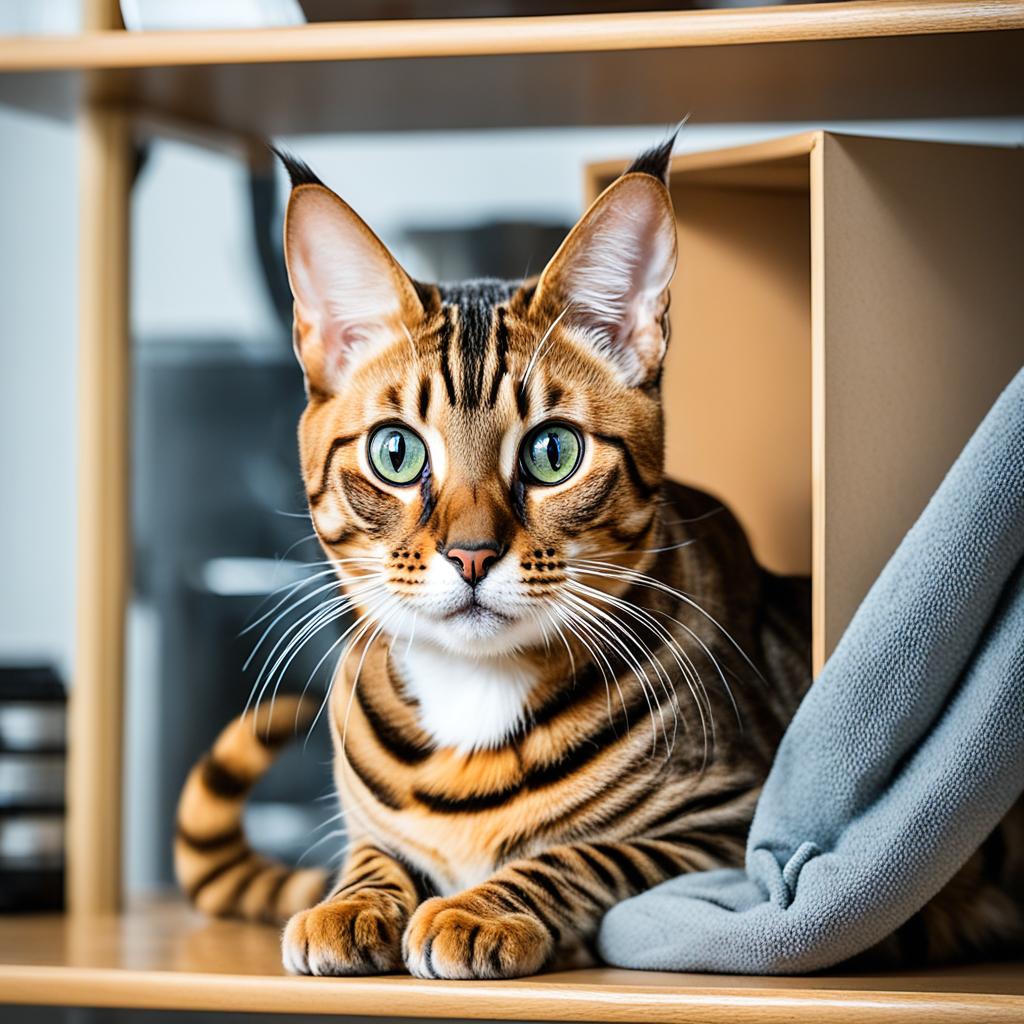
Bengal cats are extraordinary with their unique coat patterns and lively personalities. Exploring Bengal cat behavior helps us understand what brings these cats joy. This knowledge deepens our bond with them.
Characteristics of Bengal Cats
Bengal cats are full of energy and intelligence. They need mental challenges to stay happy and not get bored. Playtime for them includes games, interactive toys, and puzzling out cat puzzles. They’re curious and love to check out every corner, even places they shouldn’t be in!
Typical Behavior Patterns
These cats are always up to something, like climbing, jumping, and chasing after toys. It’s common to see a Bengal on high spots or playing intensely. They love interacting with people and their environment. Understanding their behavior helps us meet their needs better.
- High energy levels
- Curiosity-driven explorations
- Interactive play
- Affinity for climbing and perching
By knowing Bengal cats’ behavior well, we can provide a space that keeps them physically and mentally healthy. This makes for a much happier pet.
Why Is My Bengal Cat Hiding?

Has your friendly Bengal cat suddenly disappeared? There are reasons for Bengal cat hiding that need exploring. Figuring these out can help your cat feel safe again. These reasons often come from sudden noises, new people, or new pets at home. They can make your cat hide and feel scared.
Environmental Stressors
Noises, loud sounds, or chaotic weather can make a Bengal cat hide. These things disturb their peace. Too much heat, for example, might drive them to cooler, quieter spots.
Recent Changes at Home
Big changes at home can also scare your Bengal cat. They like routine and get anxious if it changes. For example, a renovation, a new friend, or a new pet can really upset them. They might hide until they feel safe again. It’s important to watch how these changes affect your cat and help calm them down.
Knowing about these reasons for Bengal cat hiding is very important. By understanding different environmental stressors and how big changes affect your cat, you can make your home a better place for them.
Possible Health Issues
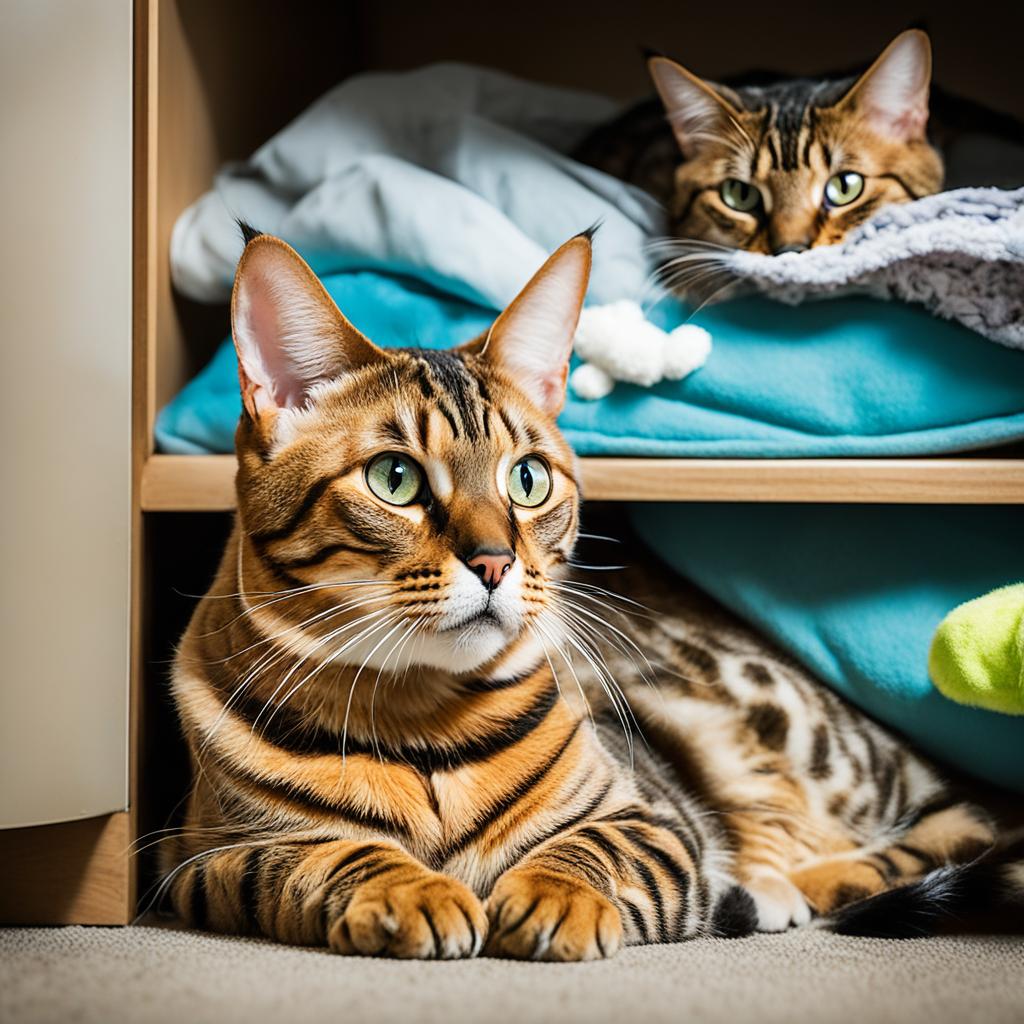
Your Bengal cat might hide due to health worries instead of normal reasons. Being alert about Bengal cat health is key. It lets you spot and deal with issues early.
Symptoms to Watch For
Watching your Bengal cat’s health means noticing key symptoms. These signs might need a vet’s check. Look for:
- Lethargy – Is your usually active cat now very lazy?
- Dramatic Appetite Changes – Big changes in eating can mean a lot about health. Overeating or losing appetite are worrisome.
- Physical Signs of Stress or Illness – Look for strange habits like too much grooming or toilet changes.
When to Visit the Vet
Some symptoms can wait, but others demand quick vet care. You should see a vet if:
- Unusual behavior lasts more than a few days.
- Your cat shows strange physical signs with their hiding.
- You see sudden weight changes or a lot of tiredness.
Being careful with your Bengal cat’s health means finding and fixing issues soon. This keeps your cat happy and lively.
| Symptom | Potential Issue | Suggestion |
|---|---|---|
| Lethargy | Possible illness or stress | Schedule a vet consultation |
| Appetite Change | Health problem or stress | Monitor for a few days; if persistent, see a vet |
| Excessive Grooming | Stress or skin condition | Check for skin issues; consult a vet if it continues |
Creating a Safe Sanctuary
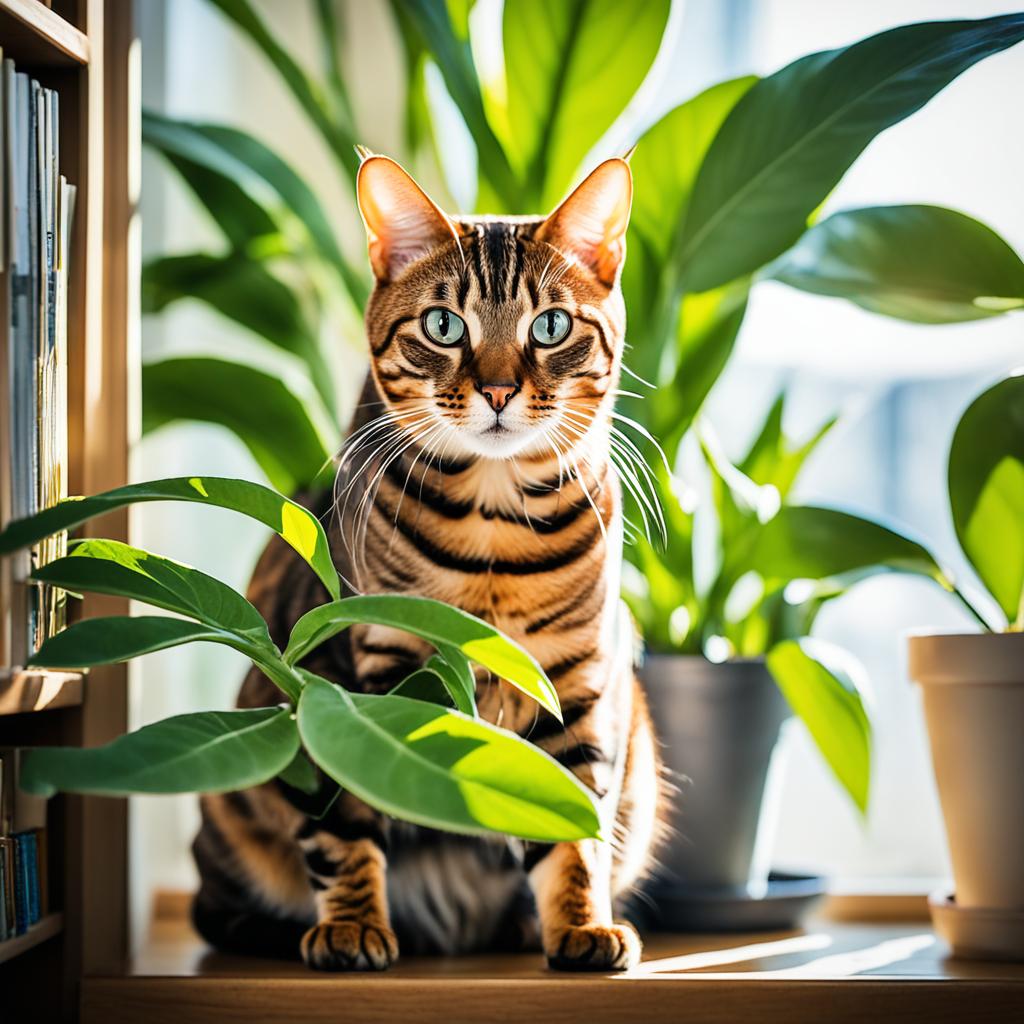
Your Bengal cat should have a place to feel safe. Let’s talk about making a cozy hideaway and why it’s so important.
Designing a Cozy Hiding Spot
It’s key to create a snug spot for your Bengal cat. You can use cat houses, hammocks, or special Bengal cat hiding spots. For example, a soft bed in a closet or a big catio is a great choice.
Here are some ideas for your cat’s special space:
- Cat Towers: These towers have levels for playing and hiding.
- Cat Houses: They give privacy and a feeling of safety.
- Hammocks: These are comfy and can go anywhere in your house.
Importance of a Quiet Space
Making sure your Bengal’s hiding spot is quiet is a must. They need peace to feel safe. Putting their area in a quiet place away from people will help them relax.
Look for quiet spots in your place where your cat can chill. This will make your cat less worried and feel safer.
Bengal Cat Anxiety
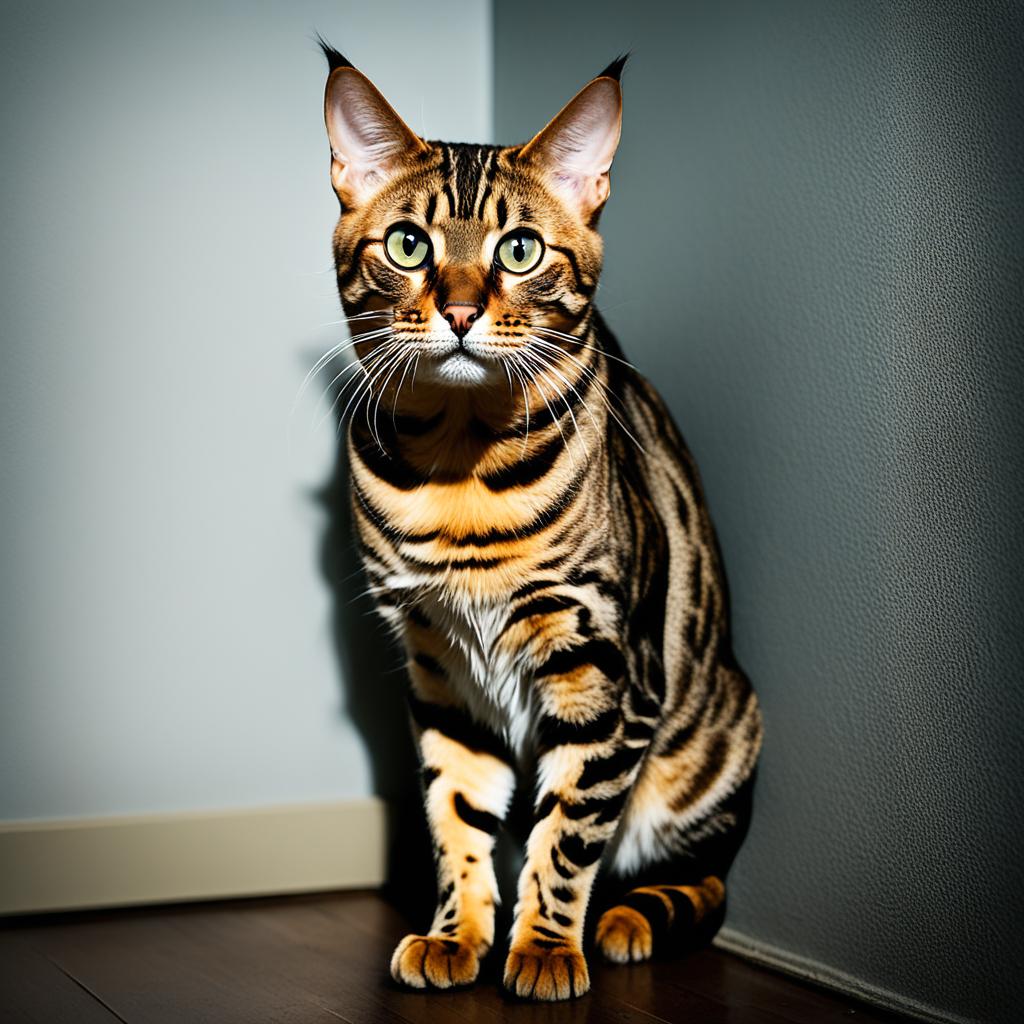
Is your Bengal cat becoming more of a loner lately? Bengal cat anxiety could be the reason. These cats are usually very active and love to play. So, if they’re hiding, it could be a warning sign.
Spotting Bengal cat anxiety involves noting changes in their actions. If they’re pulling back or seem nervous, you might see them groom a lot or avoid others. These are common signs of cat anxiety.
Anxiety in Bengals can come from changes in their space. Have you moved or brought in a new pet? Even just rearranging your home can make them uneasy. It’s important to consider all possible causes of their anxious behavior.
To help your cat feel better, you can do a few things:
- Stick to a schedule: Regular meal times and play sessions can work wonders.
- Give them a quiet place: A cozy spot for them to feel safe can ease their anxiety.
- Try calming products: Things like synthetic pheromones are made to relax cats.
Playing interactively with your cat is also a great stress-buster. Pick up toys that challenge them mentally and physically. Having their favorite toy or a soft blanket can also bring comfort and calm.
By looking out for these signs and acting on them, you can lessen your Bengal’s anxiety. This can make your home a happier and safer place for your cat.
Dealing with Multicat Households
Living with multiple cats can be complex, especially managing Bengal cat relationships and territories. Creating peace among them means understanding what each cat needs.
Introductions and Hierarchies
Introducing cats slowly is key to harmony. Start by letting them smell each other’s scents without seeing each other. This helps them adjust.
Use barriers at first and offer treats when they’re near each other. Watch how they interact to see who is more dominant. A harmonious social order is vital for a calm home.
Minimizing Territorial Conflicts
Having plenty of space for each cat is essential to prevent fights. Bengal cats love to explore, so adding cat trees and high shelves can help.
Keep an eye on their essential areas like food and litter boxes. Giving each cat their own space reduces stress and keeps peace. In a household with several cats, this balance is key.
Signs of Stress in Bengal Cats
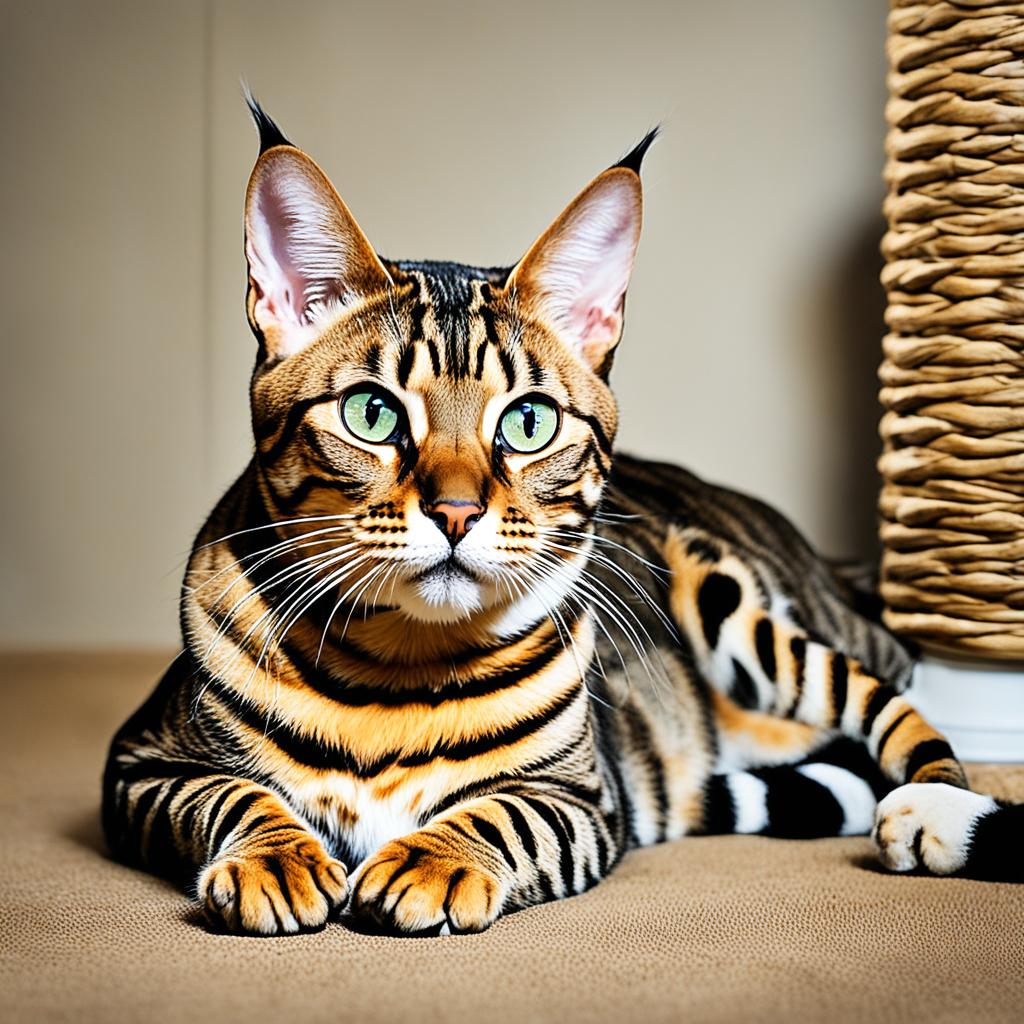
Knowing the Bengal cat stress signs is key to helping your cat before problems grow. These signs are a mix of different behaviors and body changes. They show what might be making your cat anxious.
Behavioral Changes
Watch how your cat acts closely. Do they groom too much or not enough? A change in grooming can mean stress. Also, if your cat eats a lot more or stops eating, it could be a sign of stress.
Other signs include meowing more, hiding often, or acting more aggressive or needy than usual.
Physical Indicators
Bengal cats might show signs of stress physically. If they have a hunched back or a low, tucked tail, they could be stressed. Also, unusual sounds when they meow are stress clues.
If your cat’s tail twitches a lot, it’s another sign they might be stressed. So, keeping an eye out for these behavioral and physical stress indicators can help you make things better for your Bengal cat.
| Behavioral Indicators | Physical Indicators |
|---|---|
| Excessive grooming | Hunched posture |
| Changes in eating pattern | Tucked tail |
| Increased hiding | Altered vocalizations |
| Unusual aggression | Tail twitching |
How to Coax Your Bengal Cat Out of Hiding
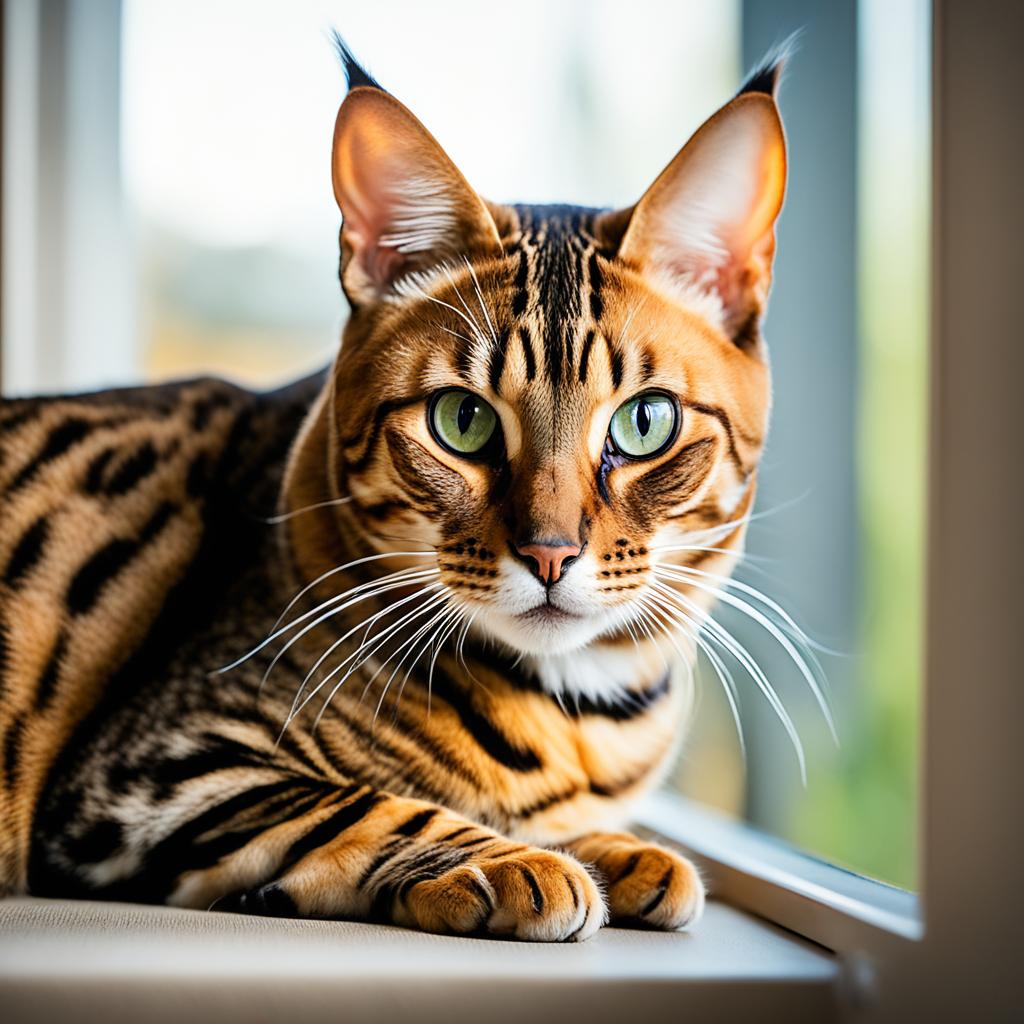
Getting your Bengal cat to show itself takes time and skill. By knowing a few things and using some clever tricks, you can help your Bengal feel more comfortable. This will make them curious and build trust with you.
Using Treats and Toys
Begin with tasty treats and fun toys. Bengals love to play and are curious. So, by using their favorite treats and toys, you can easily lure them out. A feeder ball or a laser pointer works wonders. You can also try a wand toy from a distance to draw them out.
Creating a Trusting Environment
To build trust, create a friendly atmosphere. This includes gently interacting with your cat in a way that makes them feel safe. Talk softly and move slowly near their hiding place. Over time, they will see you as a source of comfort. Remember, being patient and persistent is vital in earning their trust.
Building Trust with Your Bengal Cat

To form a strong connection with a Bengal cat, start with trust-building strategies. It’s all about gentle and positive interaction. Give your cat plenty of focused attention. This helps in earning their love.
Patience and persistence are key, but many overlook them. By not hurrying, your Bengal cat feels more at ease. Create quiet spots for them to feel secure. This greatly boosts their relaxation.
Engage your Bengal with interactive toys. It highlights your fun side and shows them you’re a source of joy. Also, giving treats bolsters your bond. It makes them happy to be around you. This step is crucial in building trust.
Understanding your Bengal’s needs is vital for a lasting friendship. Trust is the base. It helps your cat feel safe, making them less prone to hiding from stress.
Using Pheromones and Comfort Items
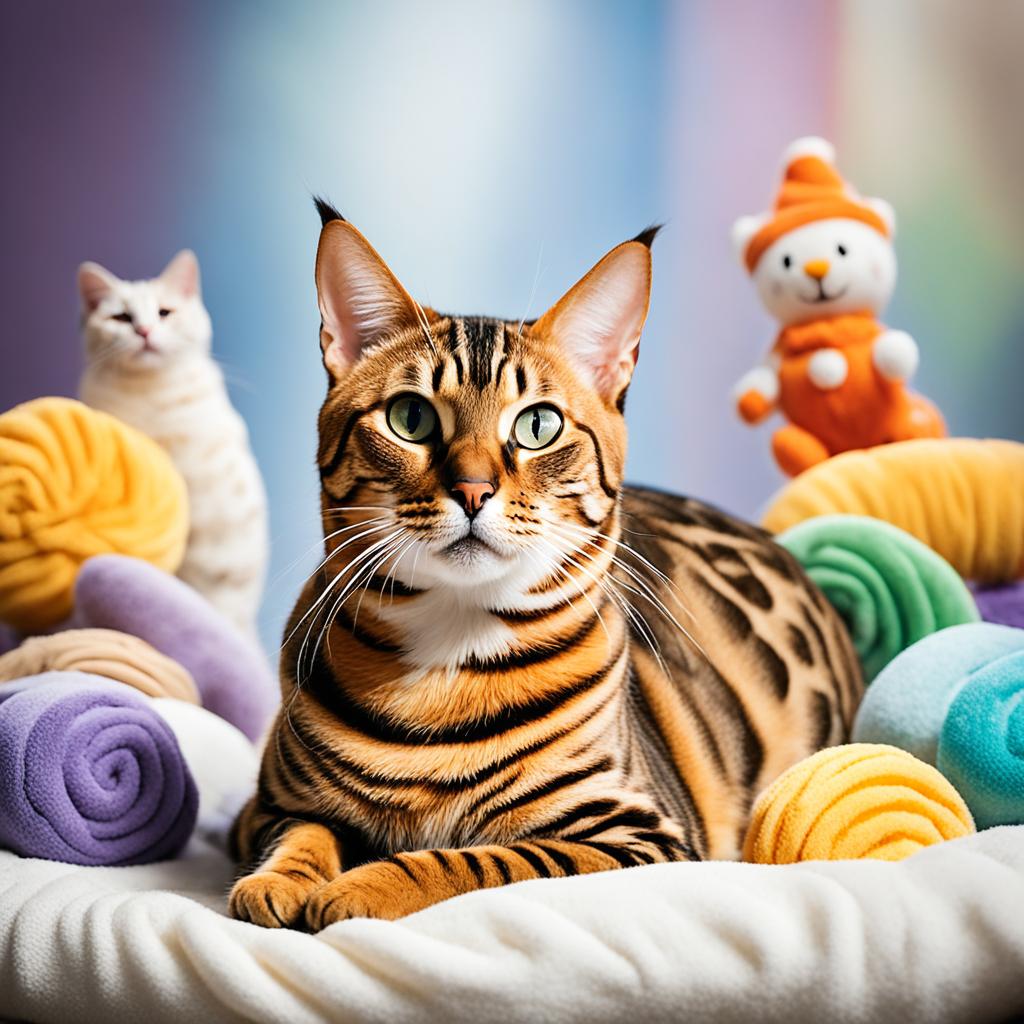
Make your Bengal cat’s space calming to cut down on hiding. Using feline pheromones and comfy things for cats helps. This creates a safe and peaceful vibe for your cat.
Feliway and Alternatives
Feliway is known for its synthetic cat pheromones. It copies the scents that make cats feel at home and secure. This can lower their anxiety and stop them from hiding.
It comes in forms like a plug-in, spray, or collar. Feliway suits various situations because of this. Brands like Comfort Zone and ThunderEase offer similar solutions too. So, you have many ways to make your cat feel better.
Favorite Blankets and Toys
Your cat’s favorite things are very important. Items like special blankets and toys have your cat’s smell on them. This makes your cat feel safe.
Adding these to your cat’s area increases their comfort. A toy mouse they adore or a cozy blanket makes a big difference. It helps reduce whatever is making your Bengal cat hide.
Consulting a Feline Behaviorist
When your Bengal cat’s behavior becomes a concern, seeking help is key for their health. If issues persist, a feline behaviorist can offer expert advice. They understand the complexities of cat behavior.
When to Seek Professional Help
Is your Bengal cat hiding a lot due to anxiety or aggression? If traditional methods don’t work, it’s time to see a feline behaviorist. They’ll create a unique plan to tackle these issues.
What to Expect During Consultations
A professional behaviorist will thoroughly evaluate your cat’s home and habits. They’ll watch your cat, learn its history, and suggest behavior changes. These personalized plans aim to better your Bengal cat’s life and strengthen your bond.
Conclusion
You’ve learned a lot about your Bengal cat’s hiding habits. It shows they are more complex than we thought. You’ve looked at reasons like stress, health, and even psychological factors. This helps you create a plan to make your cat happy and comfortable.
It’s important to make a safe space just for your cat. Also, check for health worries or things that make them anxious. Using stuff like treats, toys, or special smells can help them feel safe. This builds trust and lowers their stress levels.
Keep an eye out for signs your cat is stressed. Then, you can take steps to help them feel better. This ensures a happy home for you both.
Building a strong, caring bond with your Bengal cat is key. Stay patient and kind. It creates a place where they feel loved and can be themselves. With you, they can enjoy life fully, free of worry.




